Abstract
The use of a diffuser in hydrokinetic turbines can improve the power coefficient. However, the risk of cavitation in the rotor blades increases. Studies suggest that backward-curved blades can reduce the axial load on the rotor and therefore prevent cavitation. Therefore, this work develops an optimization procedure applied to backward-curved blades in hydrokinetic turbines with diffusers based on the Blade Element Momentum Theory. The main contribution is to consider both the sweep effect and the presence of a diffuser in the optimization in an innovative way. We use a radial transformation function that adjusts the radial position considering the curvature of the blade during optimization under the effect of the diffuser. The results showed that the increase in blade curvature resulted in greater chord distributions and twist angles, especially at the blade tips. The Prandtl’s loss factor was not sensitive to sweep, but the linked circulation increased at the blade tips, suggesting an increased risk of cavitation. Depending on the sweep angle, the optimized blades were able to mitigate or avoid cavitation. In particular, a sweep angle of 30 eliminated cavitation. This study indicated that the proposed optimization can effectively prevent cavitation, showing satisfactory results.
1. Introduction
Hydrokinetic turbines use the energy of river water flow to generate electricity and emerge as an alternative technology with low environmental impact, as unlike hydroelectric plants, they do not require dams. The operating principle of hydrokinetic turbines is similar to that of wind turbines. The technological challenges are similar from a theoretical point of view, where the classical Betz limit establishes a maximum power coefficient of 16/27 for turbines without diffusers operating under ideal conditions.
One strategy to maximize energy extraction from wind and hydrokinetic turbines is the use of a diffuser [1,2]. When coupled around the turbine rotor, the diffuser increases the mass flow rate of the fluid and, consequently, enhances the extraction of kinetic energy and the efficiency of the turbine, making it very useful, especially in regions where the water flow speed is low [3,4]. In the field of turbomachinery and pump design, the casing for a centrifugal pump has a similar function to that of a diffuser in hydrokinetic turbines, both directing the water flow so that it hits the blades at a suitable angle, maximizing the transfer of kinetic energy. Optimizing casings improves turbine efficiency and overall performance. In [5], proposed a new method to optimize the design of a centrifugal pump. The method adopted was based on an artificial intelligence algorithm and computational fluid dynamics (CFD) analysis, in which casing-specific investigations were carried out to validate the results and audit water-driven performance. The results showed that the performance of the centrifugal pump was improved, and the shape with the highest efficiency was the volute casing, whose cross section was a trapezoid rounded at the large end (Design-NKUST). In the work of [6], they proposed an optimization algorithm in pump design considering the dimensions of the cross section, tongue length and tongue angle. As a result, they achieved improvements in pump performance by changing the shape of the volute tongue and reducing the gap between the impeller and the volute.
As with centrifugal pumps, hydrokinetic turbines are susceptible to the cavitation phenomenon. When it comes to hydrokinetic turbines with a coupled diffuser, cavitation can occur due to the increase in the axial velocity of the fluid passing through it; consequently, the pressure can drop abruptly. When the static pressure becomes lower than the vapor pressure of water at a certain temperature, vapor bubbles form and collapse within the liquid; this process is known as cavitation. This effect can originate in any section of a turbine rotor blade, but it is more likely to occur near the blade tips. In this region of the blade, the tangential speed of the flow in relation to the cube is maximum; that is, when the relative speed of the flow on the surface of the blades leads to a local pressure drop below the saturation pressure of the liquid, bubbles will form. Cavitation can cause significant damage to the turbine blades, such as erosion of the surface of the blades, leading to wear and a reduction in turbine efficiency due to changes in the relationship between the lift and drag coefficients, with consequent unbalance of the rotor, leading to possible failure due to fatigue.
To mitigate cavitation, blade geometric optimization plays an important role. Considering that the energy conversion process begins when water comes into contact with the blades, optimizing the blade shape is the starting point for turbine design. The blade structure must be designed to withstand the loads experienced in extreme conditions and, at the same time, be free from cavitation. For [7], the internal and external structures of a blade play a critical role in the entire turbine, adequately resisting loading and effectively producing energy at the same time. Ref. [8] investigated the mass transfer and cavitation behavior of centrifugal pumps through numerical simulation. The authors concluded that as the blade installation angles increase to 30, the cavitation resistance of the impeller improves. Recently, studies have shown that curved blades have better aeroelastic performance in terms of greater rotor power and lower deformation than straight blades, which can reduce the axial aerodynamic load on the rotor and increase the turbine’s energy extraction efficiency [9,10,11]. Furthermore, the geometric optimization of the blade proved to be effective in avoiding the cavitation phenomenon, as pointed out by [12]. However, few studies in the literature address the sweep effect when applied to hydrokinetic turbines. This effect is defined as a forward or backward displacement of the blade axis in the rotor plane, a forward sweep when this curvature occurs in the same direction as the rotation, or a backward sweep when the blades are curved in the opposite direction to the direction of rotation [13].
In [14], the MIRAS code was used to investigate the aerodynamic performance of winglets and sweeps in a horizontal axis wind turbine. The results indicated that wind turbine blades with sweep or winglets can perform better compared to the straight blade. Their work suggests that the swept blade can improve the aerodynamic performance of wind turbines in low-speed conditions. Ref. [15] conducted a study on the influence of the sweep angle with respect to the torsion axis on the energy production over the straight blade, without increasing blade loads, for three horizontal axis wind turbines. The results showed that the backward sweep reduces the stress due to bending in the blades by up to 3 times, also reducing the fatigue load and increasing the service life, while a negative angle increases the stress by the same amount. A negative sweep angle slightly increases the generated energy (around 1.5%), while the positive angle keeps the generated energy practically constant. In [16], the authors analyzed the power and thrust coefficients of modified blades and compared the performance of the turbine with this effect in relation to the turbine without sweep angle. There was a maximum increase in power coefficient of 2.9 using a positive sweep angle, and turbines with positive sweep angles showed a small increase in power coefficient. The turbines with a negative angle showed slightly lower power coefficients than the base turbines, in addition to a reduction in the thrust coefficient, relieving the load on the turbine structure. They also concluded that the introduction of the sweep effect improves the performance of the turbine rotor, and the increase in power of turbines with positive angles can be explained due to the reduction in the radial force, which causes the stream tube to become smaller, increasing the speed at which the air passes through the rotor. Among the methodologies applied to the study of wind and hydrokinetic turbines, the Blade Element Momentum Theory (BEMT) is the most used worldwide in several applications [17,18,19]. This methodology is essentially an integral method, with semi-empirical information from aerodynamic or hydro forces in airfoil sections issued from a two-dimensional airfoil flow model or experimental data. Although conceptually simple, it is still highly useful for aero or hydrodynamics analyses of turbines, with low computational cost. This method combines the axial momentum theory and the blade element theory, first introduced by [20]. BEMT can accurately represent the aerodynamic loads acting on the rotor, and therefore, also thrust and power for different configurations of wind or water speed, rotation and pitch angle [21]. In their work, Ref. [15] proposed an efficient correction model, allowing the extension of the BEMT to turbines with curved blades. The results showed a good agreement with lift line simulations for rotors with curved blade geometry. For hydrokinetic turbines, it is well known that diffusers can improve turbine power coefficient, exceeding the Betz limit (59.3%). However, the rotor blades are susceptible to cavitation, as the diffuser increases such a phenomenon. This occurs because the installation of a diffuser around the rotor increases the axial velocity passing through the blade set, consequently reducing pressure at the blade surface, mainly at the tip. To mitigate cavitation, the geometric shape of the blade plays an important role. As mentioned before, studies available in the literature show that swept blades can reduce axial loading on the rotor, and consequently, mitigate cavitation.
To model turbines with diffuser, Ref. [22] developed a model based on the BEMT to seek an optimized straight blade geometry, in order to minimize or even avoid the occurrence of cavitation. Their optimization uses the minimum pressure coefficient as a criterion to avoid cavitation. The authors concluded that the optimization model can remove the occurrence of cavitation, making it a good alternative for the design of hydrokinetic blades under the diffuser effect. For the case of swept blade, Ref. [23] proposed a radial transformation function to the BEMT applied to turbines designed with backward-curved blades. They found that such a phenomenon strongly affects chord and twist angle distributions along the blade, increasing turbine torque and consequently power coefficient. However, their work was conducted without a diffuser. Thus, the present work aims to develop an optimization model for swept blades applied to horizontal axis hydrokinetic turbines, based on the BEMT. The main contribution of this work is to consider the rotor surrounded by a diffuser, and the blades are backward curved. So, it is intended to analyze the influence of both effects, sweep and diffuser on the distribution of chord and twist angle of the blade. As a result, for a sweep angle of 30, the blade do not experience cavitation, indicating that the proposed optimization can totally eliminate cavitation, even for turbines with a diffuser.
The other sections of this article are organized as follows: Section 2 presents the equations of axial moment and blade element momentum considering the diffuser and the radial transformation function, as well as the optimization model for swept blades under diffuser effect. Section 3 contains the results and discussions, in which the cavitation effect and the proposed blade optimization are analyzed. Finally, Section 4 shows the conclusions of this study.
2. Sweep Effect on the Blade Element Momentum Theory with Diffuser
The main purpose of this paper is to combine the optimization approaches recently developed by [22,23]. The former presented a good formulation to avoid cavitation on hydrokinetic blades under the diffuser effect; however, it does not consider swept blades. The latter demonstrated a very interesting blade optimization for swept blades, but it works only for non-shrouded rotors, without cavitation analysis. Thus, in this work, an optimization model combining both effects, diffuser and sweep, is proposed. The contribution due to the sweep effect is incorporated into BEMT for turbines with diffusers. The expressions of the proposed model are described below.
2.1. Axial Momentum Theory with Diffuser for Swept Radial Positions
To account for the sweep effect in the axial momentum theory (AMT) with a diffuser, a transformation on each radial position is necessary. Therefore, as described by [23], the AMT with sweep effect can be expressed in terms of the radial position , as show in Equation (1).
where R is the radius of the turbine at the blade tip, r is the local radius for the straight blade, and is the local swept angle. Figure 1 illustrates the swept radius on the cross section at the rotor plane.
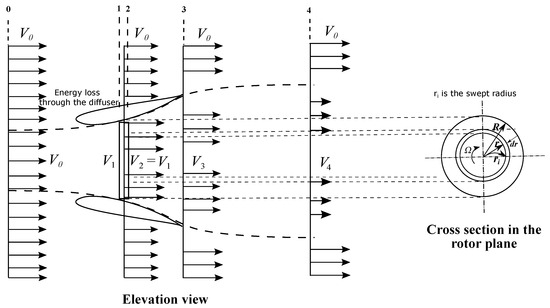
Figure 1.
Illustration of the flow velocities at the rotor plane and in the wake. The actuator disc models the swept rotor which lies between stations 1 and 2 and is surrounded by the diffuser.
In simple momentum theory, air is considered frictionless and the rotational velocity component is ignored. However, to model a diffuser with losses, an approach similar to that used to determine duct flow in the presence of losses is required. Also, the rotational component needs to be taken into account. The dashed lines in Figure 1 show the control volume used here. In this case, the elemental thrust and torque coefficients for the annular control volume are described as shown in Equations (2) and (3):
and
where . As , with , and , in which at the rotor plane. For the far-wake velocity, is defined in Equation (4), as:
where is the water speed and is the velocity in the far wake. , where A is the rotor area (assumed equal to the diffuser area at the rotor), is the cross-sectional area of the diffuser outlet, and is the diffuser efficiency, given by the ratio between static and dynamic pressures at the rotor plane and at the diffuser outlet. Note that the radial position, , in Equations (2) and (3) depends on Equation (1).
2.2. Blade Element Momentum Theory for Diffuser-Augmented Turbines with Swept Blades
For the BEMT with swept blades, as described in [23], the mathematical transformations are applied only on radius and chord, respectively, leading to , as in Equation (1), and to , where c is the local chord for a straight blade. The maximum swept angle at the blade tip is , and , where is the number of blade elements. The following mathematical demonstrations are straightforward from the BEMT analysis, where the major additional term is as in Figure 2. Note that the velocity at the rotor plane is , in which the flow angle becomes exactly as described by [23], here shown in Equation (5).
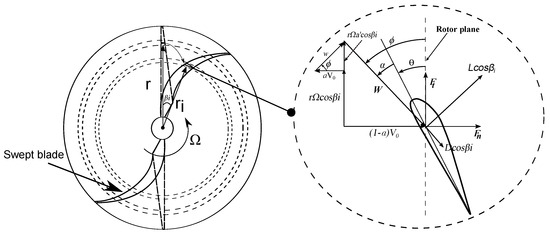
Figure 2.
Simplified illustration of the variable transformations on a swept blade [23].
The relative velocity W and the bound circulation of each element, , are described in Equations (6) and (7) [23]
and [24]
where and are the lift and drag coefficients, respectively. The normal and tangential force coefficients and are shown in Equations (8) and (9) [23]:
and
For the case of a swept rotor surrounded by a diffuser, the formulations for axial and tangential flow velocities can be calculated using Equations (10) and (11), respectively:
2.3. Optimization Model for Swept Blades under Diffuser Effect
The optimization model needs to incorporate and into the equations described in [22]. For that, it is performed by maximizing the power coefficient through Equation (5) of [22], leading to Equation (14) described as
where and
Once is determined, the optimum axial induction factor, , can be calculated making . From [22], the optimum chord for a swept blade at each section is given by Equation (16).
Note that the parameter is introduced in Equation (16). To calculate the tangential induction factor, , Equation (21) from [22] is used. Here, this equation is given by (17).
where is the local speed ratio. The optimum twist angle, is determined using the following Equation (18) obtained from the velocity diagram in Figure 2.
The proposed optimization is solved straightforwardly through the analytical Equations (14), (16) and (18). Only Equation (14) needs the Newton–Raphson method to be solved. Furthermore, optimization models based on BEMT, such as Glauert’s approach, use a fixed angle of attack, in which the blade is optimized to ensure that the effective angle of attack has an optimum value at each blade section. The optimum angle of attack is assumed to be the one at maximum . Here, , and are the optimum values used for NACA 65(3)-618 at . All equations come from the control volume analysis illustrated in Figure 1, through energy, momentum, and mass conservation principle. The algorithm to calculate the optimum blade is described in Algorithm 1 below, starting at the tip, is described below, using the following as input: r, B, , , , , , , and .
| Algorithm 1 Procedure for calculating the optimum blade geometry. |
3. Results and Discussion
The results are compared to the data obtained by [22], which uses computational fluid dynamics to analyze cavitation inception on a hydrokinetic turbine with 3 blades and 10 m diameter. Here, such a turbine is assessed by considering forward and backward-curved blades, including the diffuser effect. It is worth noting that the proposed optimization is solved using the analytical Equations (14), (16) and (18).
3.1. Analysis of the Cavitation Effect
Diffuser-augmented hydrokinetic turbines have a great possibility of cavitation, mainly medium and large rotors. This is because the diffuser changes axial flow velocity and pressure at the rotor plane. To prevent this phenomenon from interfering with the rotor performance, it is essential to analyze the conditions necessary to avoid it. First, we verify the influence of blade curvature on the appearance of cavitation, evaluating four cases for different sweep angles in relation to the relative velocity W and the cavitation velocity criterion (see Equation (4) from [22]). The turbine parameters taken into account for the simulations are the same in each case, according to Table 1. The water flow velocity is uniform ( m/s), and it is adopted as the initial parameter. The airfoil of each blade section is the NACA 65(3)-618 as described by [25], where lift and drag are obtained through the free software XFoil implemented in XFLR5 6.58, for Reynolds number between to for a rotor with 10 m diameter, as in Table 1. Figure 3 and Figure 4 show the comparison between W and as a function of the radial position. The cavitation can be assessed from the velocity . According to [25], the hydraulic pressure varies along the rotor blade and cavitation is more likely near the tip of the top blade where static pressure is lower. The static pressure condition on an elementary blade section, consequently, leads to the cavitation velocity .

Table 1.
Parameters used in the turbine design.
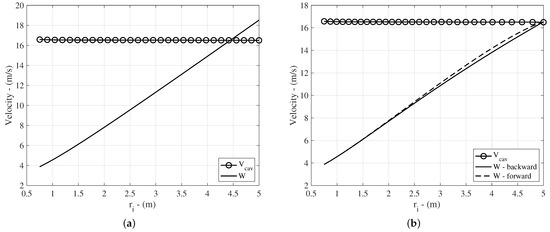
Figure 3.
Blades under cavitation effect: (a) (straight blade), and (b) .
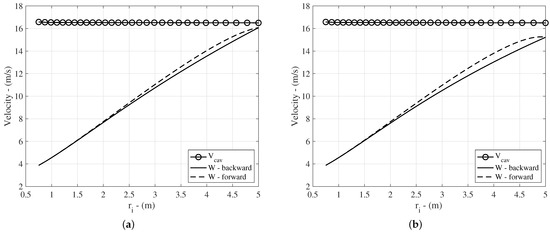
Figure 4.
Blades free from cavitation effect: (a) , and (b) .
The result in Figure 3a, reveals that for a straight blade, , for m, indicating cavitation inception at the blade tip. On the other hand, for a backward-curved blade, , the cavitation inception totally disappears, as W remains less than (Figure 3b). The same behavior occurs for a forward-curved blade . The difference between backward- and forward-curved blades is the non-linearity of the relative velocity W, which increases as the sweep angle increases. As explained in [26], at the blade tip, high W leads to low static pressure, making this blade region more susceptible to the inception of vapor bubble nucleation. Thus, W is an important parameter to control cavitation inception on a turbine blade. As the sweep effect curves the blade, it alters the flow condition passing through the rotor, varying pressure at the blade surface. So, the reason W remains lower than is directly related to the change in the curvature of the blade geometry. In order to evaluate the physical consistency of this result, it also appears on marine propellers with skew. A study on the impact of skew on propeller cavitation is conducted by [27], which shows that a larger skew angle reduces cavitation. According to [28], the skew angle directly impacts cavitation dynamics and this is associated with the variation of the vortex shedding from the blade propeller. The same skew angle is applied for a marine propeller, whereas the sweep angle is used for the hydrokinetic turbine. Figure 4a,b show the results for and , respectively. The negative signal indicates forward-curved blades. Note that, for sweep angles higher than or lower than , cavitation inception does not occur as W is always less than . In [22], cavitation occurs in approximately 80% of the blade length with correction on the chord distribution to avoid it. However, here, the sweep effect included in the proposed optimization avoids cavitation inception without any correction on the model.
An important criterion for analyzing the phenomenon of cavitation in hydrokinetic turbines is to relate the dimensionless factor () known as the Thoma number, with the minimum pressure coefficient (), so then the cavitation occurs when . This condition was investigated as a function of the radial position of the blade element of a turbine with a diffuser, comparing them with the results obtained by [22]. The values found are shown in Table 2, which depicts the results only for a sweep angle of and a backward-curved blade.

Table 2.
Cavitation analysis for each blade section.
The radial position is the transformation on r made through Equation (1), and it is the transformation function for a curved blade. Comparing these positions, it is possible to observe that such a function has a decreasing effect of r due to the curvature of the blade, as the curved blade increases its length, keeping the same rotor diameter. It is also emphasized that although the values of differ from [22], both are in the same radial section, with r [m] referring to a straight blade and [m] to a curved blade. Regarding the cavitation criterion, the values obtained for were greater than zero, considering a backward-curved blade, which means that each section analyzed did not present cavitation inception, while [22] observed that the cavitation starts earlier, from a m radial position of the blade to the tip for a straight blade. This outcome demonstrates that swept rotor blades can avoid cavitation inception for hydrokinetic turbines, as shown through the minimum pressure coefficient criterion.
3.2. Blade Optimization Results
From here, all results will be shown only for compared to the straight blade . In Figure 5, the results for chord and twist angle at each section of the blade are presented as a function of the radial position for different sweep angles. Comparing the chord distribution for the straight blade with backward and forward blades, the chord strongly increases after m. This is a direct consequence of the increase in the sweep angle. This effect is mostly at the tip of the blade as shown in Figure 5. According to Equation (16), the optimum chord is inversely proportional to , so the maximum increase on the chord is at the blade tip. At the root and tip of the blade, the chord does not tend to zero, in agreement with the results depicted in [22], as Prandtl’s tip loss is used. According to this author considering the diffuser effect in the blade optimization process, the chord will never be zero at the root and tip of the blade. This behavior is because the additional terms in Equation (4) are related to the diffuser. In this case, thrust coefficient , and diffuser efficiency , which are constant and always higher than zero in the model. This significantly contributes to avoiding cavitation.
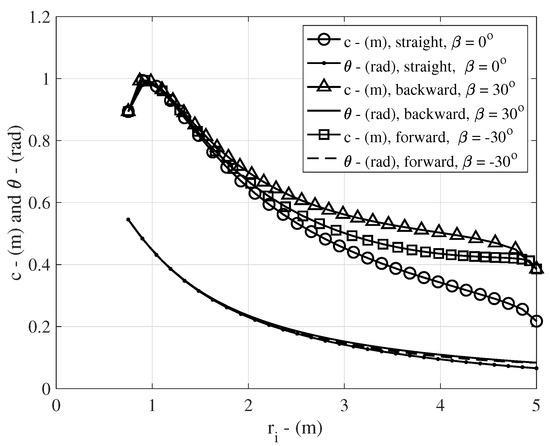
Figure 5.
Chord and twist angle distributions for straight blades and backward- and forward-curved blades.
It is important to point out that increasing the chord as observed produces significant changes in the torque produced by the rotor, which is interesting for starting turbines operating at low flow speeds. According to [29,30], regardless of the type of airfoil adopted, increasing the twist angle and the length of the chord in the root section reduces the turbine starting time because the rotor hydrodynamic torque increases with the chord. In [31], the optimization algorithm found larger values for chord and twist in the root part of the blade to improve the turbine rotation at low wind speeds. Figure 6 presents a visualization of the straight and the curved blades optimized using the proposed model. In this case, the curved blade was optimized considering a sweep angle of 30 in relation to the straight blade tip.
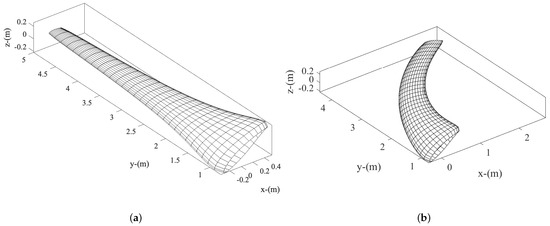
Figure 6.
Blade geometry: (a) (straight blade) (b) (backward-curved blade).
Figure 7 shows how the sweep and diffuser effects impact the behavior of the Prandtl tip loss factor, F, taking it to zero at the blade root and tip. It is observed that F does not change its curve for different sweep angles (Figure 7a), meaning that Prandtl’s factor is not sensitive to the sweep effect, but it is just a little susceptible to the effect caused by the diffuser (Figure 7b). This result agrees with that found in [22], who included the diffuser effect in their optimization model. In [23], obtained the same result on F comparing straight and backward-curved blades only. In their work, it was observed that the curves for both blades are almost the same, indicating little influence on the blade geometry.
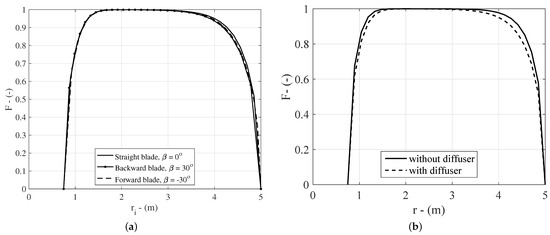
Figure 7.
Prandtl tip loss factor under diffuser and sweep effects: (a) Present work and (b) Picanço et al. [22].
As described by [23], the behavior of F suggests that Prandtl’s tip loss factor is not adapted to swept rotors. Methods based on finite blade functions [32] are good alternatives, as they are dependent on the circulation, and the vortex shedding from the blade is modified by the sweep effect. However, usually they are more complex to implement.
In Figure 8, the bound circulation of the blade is shown. It is observed that the sweep effect strongly impacts , especially in the region of the blade tip. Such an impact on is mainly due to chord variation, as demonstrated in Equation (7), since and are constant in the proposed optimization. This is an important result because it demonstrates that hydrodynamic torque also increases as a consequence of Kutta–Joukowsky theorem. Note that increases because it is a response of the optimization model, which increases chord distribution close to the blade tip, consequently reducing or avoiding cavitation.
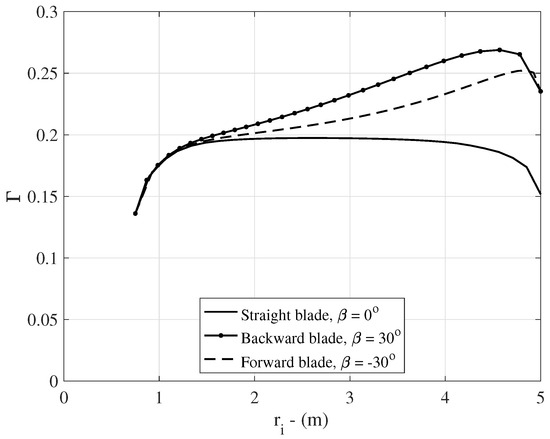
Figure 8.
Bound circulation, .
Figure 9 shows that the optimum axial induction factor is constant for straight and swept blades in the proposed model (). This result is expected, as Equation (14) depends only on the diffuser parameters, , , and . On the other hand, the tangential induction factor, , varies for each blade section, but not in relation to the sweep angle. This occurs because is inversely proportional to , as in Equation (17). The main effect of the optimization is on the geometric parameters and , Equations (16) and (18), respectively, which strongly vary with the radial transformation shown in Equation (1).
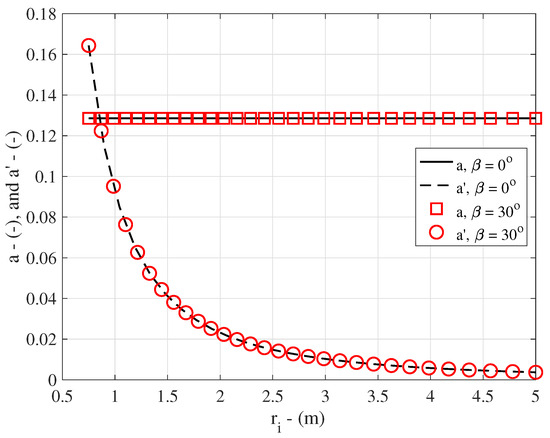
Figure 9.
Induction factors for and , at operating condition .
4. Conclusions
This work presents a new optimization model for hydrokinetic turbines, considering diffuser and swept blades. The analysis highlights the influence of sweep and diffuser on the chord and blade twist distribution, avoiding cavitation in swept rotors. The proposed optimization, based on BEMT with a radial transformation function, demonstrated the importance of considering the sweep effect on the circulation and loss of the blade tip, whereas the Prandtl factor proved to be insensitive to the sweep effect, as it is on classical models that do not foresee this effect. Regarding cavitation, under the criterion of the minimum pressure coefficient in the string optimization process, it was observed that this phenomenon did not occur in each radial section. Therefore, the sweep effect (for ) is the most significant factor in reducing cavitation in hydrokinetic turbines with a diffuser. This work theoretically investigated the sweep and diffuser effects on hydrokinetic turbine blades. In future research, blades optimized with this model will be manufactured to obtain experimental results. Furthermore, as a suggestion for future work, the occurrence of cavitation in the rotor blades can be analyzed through numerical simulation using CFD, which can be compared with the results obtained in this work. Additionally, stress on high-sweep angle blades is an important issue to be addressed in the future.
Author Contributions
Writing—review and editing, S.C.d.P.A., D.A.T.D.d.R.V. and J.R.P.V. All authors have read and agreed to the published version of the manuscript.
Funding
This research received no external funding.
Institutional Review Board Statement
Not applicable.
Informed Consent Statement
Not applicable.
Data Availability Statement
Data are contained within the article.
Acknowledgments
The authors would like to thank the CNPq, CAPES, PROPESP/UFPA (PAPQ) and IFAM for supporting.
Conflicts of Interest
The authors declare no conflict of interest.
Nomenclature
| Latin Symbols | |
| a, | Axial and tangential induction factors at the rotor |
| Optimum axial induction factor | |
| B | Number of blades |
| c | Chord (m) |
| Drag coefficient | |
| Lift coefficient | |
| Torque coefficient | |
| Normal force coefficient | |
| Power coefficient | |
| Optimum power coefficient | |
| Tangential force coefficient | |
| Thrust coefficient | |
| Elementary area (m) | |
| F | Prandtl Tip-loss factor |
| Pressure in the external flow (Pa) | |
| Pressure at the turbine upstream (Pa) | |
| Pressure at the diffuser outlet (Pa) | |
| P | Output power (W) |
| r | Radial position at the rotor plane (m) |
| R | Radius of the rotor (m) |
| Freestream wind velocity (m/s) | |
| Axial velocity at the diffuser outlet (m/s) | |
| w | Total induced velocity (m/s) |
| W | Relative velocity (m/s) |
| x | Local-speed ratio |
| Greek Symbols | |
| Angle of attack (rad) | |
| Twist angle (rad) | |
| Tip-speed ratio | |
| Density of the fluid (kg/m) | |
| Solidity of the turbine | |
| Flow angle (rad) | |
| Angular speed of the turbine (rad/s) |
References
- Wang, W.-Q.; Song, K.; Yan, Y. Influence of interaction between the diffuser and rotor on energy harvesting performance of a micro-diffuser-augmented hydrokinetic turbine. Ocean. Eng. 2019, 189, 106293. [Google Scholar] [CrossRef]
- Nunes, M.M.; Mendes, R.C.F.; Oliveira, T.F.; Brasil Junior, A.C.P. An experimental study on the diffuser-enhanced propeller hydrokinetic turbines. Renew. Energy 2019, 133, 840–848. [Google Scholar] [CrossRef]
- Stadler, C.; Wack, J.; Riedelbauch, S. Investigation of the Operating Principle of Diffuser Augmented Hydrokinetic Turbines. IOP Conf. Ser. Earth Environ. Sci. 2021, 774, 012138. [Google Scholar] [CrossRef]
- Rezek, T.J.; Camacho, R.G.R.; Filho, N.M.; Limacher, E.J. Design of a Hydrokinetic Turbine Diffuser Based on Optimization and Computational Fluid Dynamics. Appl. Ocean. Res. 2021, 107, 102484. [Google Scholar] [CrossRef]
- Wang, C.-N.; Yang, F.-C.; Nguyen, V.T.T.; Vo, N.T.M. CFD Analysis and Optimum Design for a Centrifugal Pump Using an Effectively Artificial Intelligent Algorithm. Micromachines 2022, 13, 1208. [Google Scholar] [CrossRef] [PubMed]
- Nguyen, V.T.T.; Vo, T.M.N. Centrifugal Pump Design: An Optimization. In Proceedings of the International Conference on Research in Engineering, Technology and Science (ICRETS), Baku, Azerbaijan, 1–4 July 2022. [Google Scholar]
- Nguyen, Q.D.; Park, H.C.; Kang, T.; Ko, J.H. Dynamic analysis of composite blade for horizontal-axis tidal lade for horizontal-axis tidal turbine. Sci. Eng. Compos. Mater. 2018, 25, 1075–1083. [Google Scholar] [CrossRef]
- Li, G.; Ding, X.; Wu, Y.; Wang, S.; Li, D.; Yu, W.; Wang, X.; Zhu, Y.; Guo, Y. Liquid-vapor two-phase flow in centrifugal pump: Cavitation, mass transfer, and impeller structure optimization. Vacuum 2022, 201, 111102. [Google Scholar] [CrossRef]
- Amoozgar, M.R.; Shaw, A.D.; Friswell, M.I. The effect of curved tips on the dynamics of composite rotor blades. Aerosp. Sci. Technol. 2020, 106, 106197. [Google Scholar] [CrossRef]
- Sessarego, M.; Feng, J.; Ramos-García, N.; Horcas, S.G. Design optimization of a curved wind turbine blade using neural networks and an aero-elastic vortex method under turbulent inflow. Renew. Energy 2020, 146, 1524–1535. [Google Scholar] [CrossRef]
- Thangavelu, S.K.; Chow, S.F.; Sia, C.C.V.; Chong, K.H. Aeroelastic performance analysis of horizontal axis wind turbine (HAWT) swept blades. Mater. Today Proc. 2021, 47, 4965–4972. [Google Scholar] [CrossRef]
- Menéndez Arán, D.; Menéndez, Á. Surrogate-Based Optimization of Horizontal Axis Hydrokinetic Turbine Rotor Blades. Energies 2021, 14, 4045. [Google Scholar] [CrossRef]
- Verelst, D.R.; Larsen, T.J. Load Consequences When Sweeping Blades—A Case Study of a 5 MW Pitch Controlled Wind Turbine; Denmark. Forskningscenter Risoe. Risoe-R No. 1724(EN); Danmarks Tekniske Universitet, Risø National Laboratoriet for Bæredygtig Energi: Kongens Lyngby, Denmark, 2010. [Google Scholar]
- Sessarego, M.; Ramos-García, N.; Shen, W.Z. Analysis of winglets and sweep on wind turbine blades using a lifting line vortex particle method in complex inflow conditions. J. Phys. Conf. Ser. 2018, 1037, 022021. [Google Scholar] [CrossRef]
- Larwood, S.; Van Dam, C.P.; Schow, D. Design studies of swept wind turbine blades. Renew. Energy 2014, 71, 563–571. [Google Scholar] [CrossRef]
- Kaya, M.N.; Kose, F.; Ingham, D.; Ma, L.; Pourkashanian, M. Aerodynamic performance of a horizontal axis wind turbine with forward and backward swept blades. J. Wind. Eng. Ind. Aerodyn. 2018, 176, 166–173. [Google Scholar] [CrossRef]
- Abutunis, A.; Hussein, R.; Chandrashekhara, K. A neural network approach to enhance blade element momentum theory performance for horizontal axis hydrokinetic turbine application. Renew. Energy 2019, 136, 1281–1293. [Google Scholar] [CrossRef]
- Tahir, A.; Elgabaili, M.; Rajab, Z.; Buaossa, N.; Khalil, A.; Mohamed, F. Optimization of small wind turbine blades using improved blade element momentum theory. Wind Eng. 2019, 43, 299–310. [Google Scholar] [CrossRef]
- Hou, H.; Shi, W.; Xu, Y.; Song, Y. Actuator disk theory and blade element momentum theory for the force-driven turbine. Ocean Eng. 2023, 285, 115488. [Google Scholar] [CrossRef]
- Glauert, H. Airplane Propellers. In Aerodynamic Theory; Durand, W.F., Division, L., Eds.; Springer: New York, NY, USA, 1935; pp. 169–360. [Google Scholar]
- Hansen, M. Aerodynamics of Wind Turbines, 2nd ed.; Earthscan: London, UK, 2008. [Google Scholar]
- Picanço, H.P.; Lima, A.K.F.d.; Rio Vaz, D.A.T.D.d.; Lins, E.F.; Vaz, J.R.P. Cavitation Inception on Hydrokinetic Turbine Blades Shrouded by Diffuser. Sustainability 2022, 14, 7067. [Google Scholar] [CrossRef]
- Gemaque, M.L.; Vaz, J.R.P.; Saavedra, O.R. Optimization of hydrokinetic swept blades. Sustainability 2022, 14, 13968. [Google Scholar] [CrossRef]
- Wood, D. Small Wind Turbines: Analysis, Design, and Application, 1st ed.; Springer: London, UK, 2011; p. 272. [Google Scholar]
- Silva, P.A.S.F.; Shinomiya, L.D.; Oliveira, T.F.d.; Vaz, J.R.P.; Mesquita, A.L.A.; Junior, A.C.P.B. Analysis of cavitation for the optimized design of hydrokinetic turbines using BEM. Appl. Energy 2017, 185, 1281–1291. [Google Scholar] [CrossRef]
- Silva, P.A.S.F. Estudo Numérico de Turbinas Hidrocinéticas de Eixo Horizontal. Master’s Thesis, Department of Mechanical Engineering, University of Brasília, Brasília, Brazil, 2014. [Google Scholar]
- Hu, J.; Zhang, W.; Wang, C.; Sun, S.; Guo, C. Impact of skew on propeller tip vortex cavitation. Ocean Eng. 2018, 220, 108479. [Google Scholar] [CrossRef]
- Wang, Y.; He, C.; Wang, X.; Cheng, H.; Ji, B. Influence of skew angle on the cavitation dynamics and induced low-frequency pressure fluctuations around a marine propeller. Ocean Eng. 2023, 277, 114302. [Google Scholar] [CrossRef]
- Akbari, V.; Naghashzadegan, M.; Kouhikamali, R.; Afsharpanah, F.; Yaïci, W. Multi-Objective Optimization and Optimal Airfoil Blade Selection for a Small Horizontal-Axis Wind Turbine (HAWT) for Application in Regions with Various Wind Potential. Machines 2022, 10, 687. [Google Scholar] [CrossRef]
- Rahgozar, S.; Pourrajabian, A.; Kazmi, S.A.A.; Kazmi, S.M.R. Performance analysis of a small horizontal axis wind turbine under the use of linear/nonlinear distributions for the chord and twist angle. Energy Sustain. Dev. 2020, 58, 42–49. [Google Scholar] [CrossRef]
- Pourrajabian, A.; Ebrahimi, R.; Mirzaei, M. Applying micro scales of horizontal axis wind turbines for operation in low wind speed regions. Energy Convers. Manag. 2014, 87, 119–127. [Google Scholar] [CrossRef]
- Wood, D. Wake Expansion and the Finite Blade Functions for Horizontal-Axis Wind Turbines. Energies 2021, 14, 7653. [Google Scholar] [CrossRef]
Disclaimer/Publisher’s Note: The statements, opinions and data contained in all publications are solely those of the individual author(s) and contributor(s) and not of MDPI and/or the editor(s). MDPI and/or the editor(s) disclaim responsibility for any injury to people or property resulting from any ideas, methods, instructions or products referred to in the content. |
© 2023 by the authors. Licensee MDPI, Basel, Switzerland. This article is an open access article distributed under the terms and conditions of the Creative Commons Attribution (CC BY) license (https://creativecommons.org/licenses/by/4.0/).